
Standing tall: How strategic use of PGR helping feed barley resist lodging
July 2025
Research Team
Dr. Balwinder Kumar, crop research scientist
Dr. Haider Abbas, crop research scientist
Emily Gannon, research technician
Summer students and other staff
Collaborators
SARDA Ag Research, Donnelly, Alta.
Farming Smarter, Lethbridge, Alta.
Funders
This research was made possible through the generous support of our funding partners, including Alberta Grains, Western Grains Research Foundation (WGRF), Manitoba Crop Alliance, SaskBarley, Alberta Beef Producers, Results Driven Agriculture Research (RDAR), and Syngenta. Their commitment to advancing practical solutions for lodging management in feed barley has been instrumental in driving this work forward for the benefit of producers across Western Canada.
Summary
Average barley yields have stagnated in recent years partly due to lodging, soil fertility decline and extreme climate variability. In 2022, the project “Maximizing feed barley yield while minimizing lodging” was launched with the aim of identifying effective plant growth regulator (PGR) strategies to reduce lodging and optimize grain yield. The study evaluates the interaction between barley genetics, PGR timing, dosage and tank mix combinations under western Canada conditions.

Background
Barley is one of the oldest domesticated cereal grains and remains vital to global and Canadian agriculture. In 2024, Canada produced approximately nine million tons of barley, ranking as the fifth-largest barley producer in the world. Of this, more than 36 per cent is exported, contributing significantly to agri-food trade. Domestically, 30 per cent of barley is used for animal feed in Western Canada, with the remainder used in malting and food industries. Alberta leads in national production, contributing over 50 per cent of Canada’s total barley output.
Feed barley plays a central role in Western Canada’s livestock systems, particularly in beef finishing rations, dairy production, and swine diets, thanks to its high starch (55-60 per cent), moderate protein (10-12 per cent), and good fiber profile.
Lodging can reduce barley yields by 15-40 per cent, depending on growth stage and severity. It also lowers grain quality, complicates harvesting, and increases disease risk. In high input systems, where producers push yield boundaries through intensive fertility and seeding practices, the risk of lodging escalates.
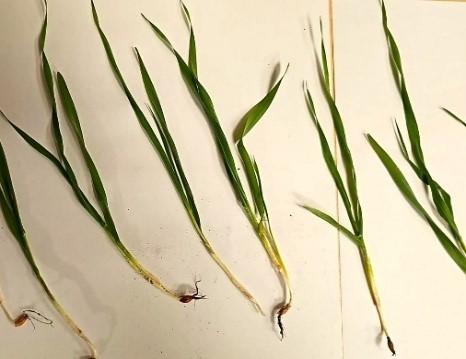
BBCH 21-24 (Early tillering)
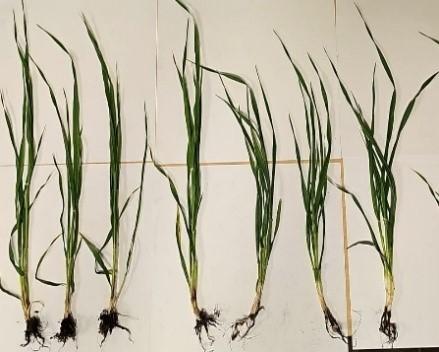
BBCH 30-32 (Stem elongation stage)
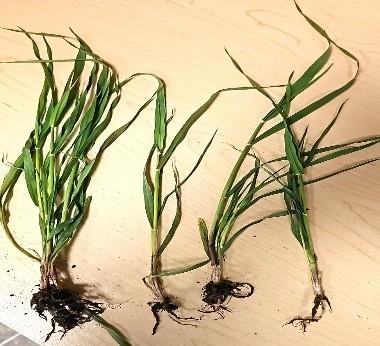
BBCH 37 (Flag leaf emergence stage)
Feed barley growth stages for application of Moddus for mitigating lodging at Vermilion

The study
Timeline
Three years (2022-2024)
Location
The project was completed across three diverse agro-climactic sites in Alberta:
Vermilion (Lakeland College)
Lethbridge (Farming Smarter)
Falher (SARDA) Methodology
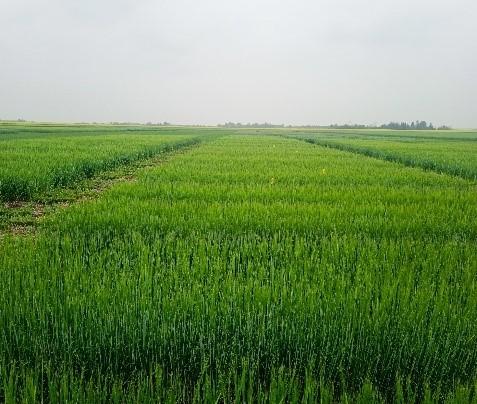
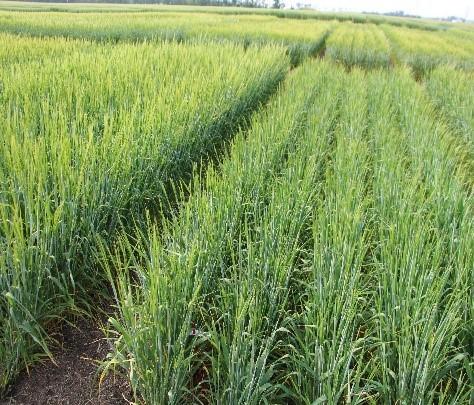

Objectives
1. Understand how barley cultivars with different genetic traits (old genetics, new genetics and European genetics) respond to PGR applications.
2. Explore Moddus PGR application timings on feed barley to consistently minimize lodging while maximizing yield and quality.
3. Determine production efficiencies by tank-mixing PGRs with herbicides and foliar fungicides.
4. Establish the yield and yield variability of newly registered barley varieties, grown under intensive agronomic management


Tractor mounted boom sprayer used for spraying Moddus
Methodology
Feed barley varieties tested 3: CDC Austenson (old), AB (new) Hague and Esma (European germplasm)
PGR treatments
A total of nine Moddus (Trinexapac-ethyl) PGR treatments including control (no PGR) were evaluated across multiple growth stages and tank-mix combinations. These treatments were designed to optimize timing, dose, and synergistic interactions with other crop inputs. The treatment strategies included:
Single low-rate applications @ 62.5 g ai ha-1 at GS 21-24, 30-32, or 37
Single full-rate applications @125 g ai ha-1 at GS 30-32 or 37
Split applications at GS 21-24 + GS 30-32 or GS 37
Tank mixes with herbicide (Axial Xtreme iPak) or fungicide (Miravis Neo) at GS 21-24 or GS 37
Untreated control
Each treatment was assessed for its effect on plant height, lodging index, grain yield, and forage quality metrics, including crude protein and neutral detergent fiber (NDF) content.


Results
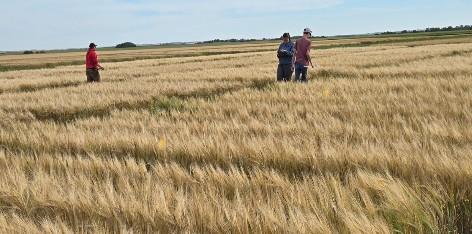
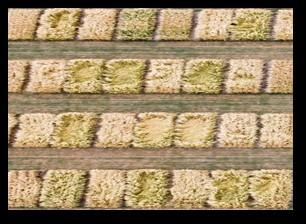
The study revealed strong support for the strategic use of Moddus PGR in reducing plant height and Lodging. Some key findings include:
Plant height reduction: All PGR treatments reduced plant height. Esma showed the greatest reduction (-7.3 cm) as compared to CDC Austenson, while the higher dose of Moddus application at flag leaf emergence proved most effective for reducing the plant height.
Lodging suppression: Lodging index decreased by PGR in treated plots. Significant and most substantial reduction occurred when Moddus was tankmixed with fungicide at GS 37 or applied in split doses.
Yield response: The split application of Moddus 62.5 g/ha at early tillering (GS 21-24) tank-mixed with herbicide, followed by 62.5 g/ha at stem elongation (GS 30-32) achieved a significant yield increase of 9.0 bu/ac by effectively suppressing early vegetative growth, enhancing stem strength, and improving operational efficiency without compromising efficacy. The recommended stages of application by Syngenta were second best treatment.

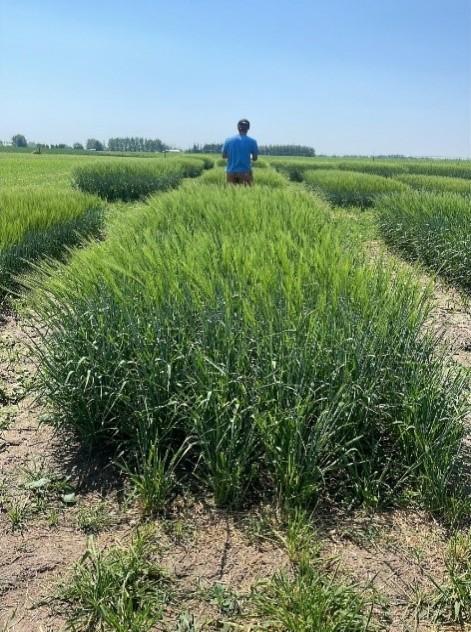
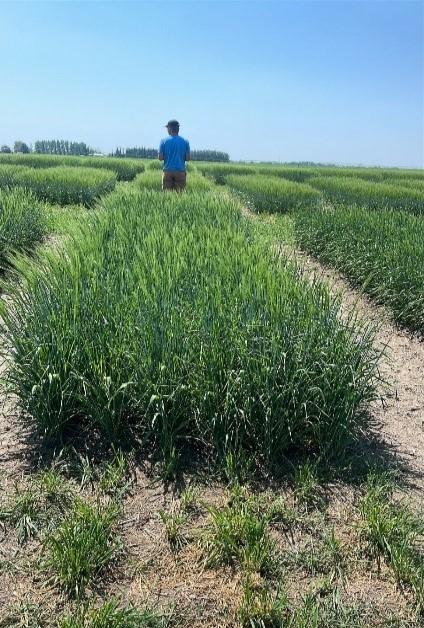
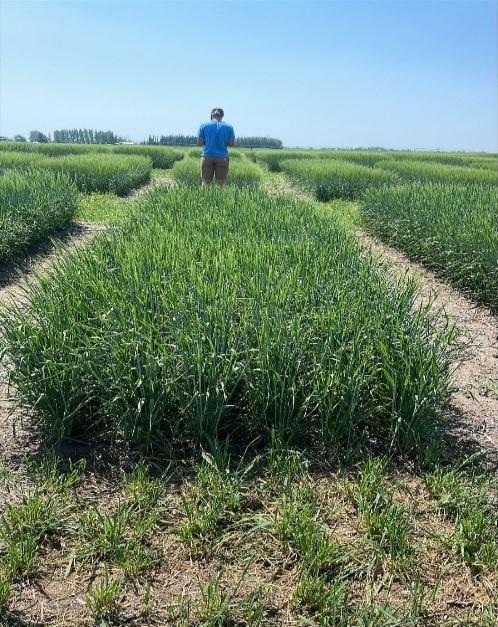
Performance of Moddus PGR in feed barley at Lethbridge in comparison with control
Variety-specific effects: Esma and AB Hague had good standability and maintained a better yield (+6.14 and +2.15) as compared to CDC Austenson, although the differences were not significant. AB Hague recorded a significantly higher lodging index due to more plant height.
Grain quality: Protein content was marginally affected, with slight reductions (0.26 per cent) in Esma and it also recorded significantly higher fibers (NDF) than CDC Austenson. AB Hague has significantly lower NDF content than other two cultivars.
Operational efficiency via tank mixing: Tank-mixing Moddus with herbicides (tillering stage) and fungicides (flag leaf emergence) eliminated additional sprayer passes, improving logistical efficiency and saving $10-12/ac. No compatibility or crop injury issues were observed, confirming the field readiness of integrated spray strategies.
Regional differences: At Vermilion, all varieties performed consistently. At Falher, CDC Austenson excelled. At Lethbridge, Esma outperformed others under drought-prone, windy conditions. However, overall, linear mixed modeling

results revealed that Esma performed better in terms of yield than other two varieties.
Economic return: Split Moddus PGR application at GS 21-24 (early tillering) + at GS 30-32 (stem elongation) yielded the highest net return of $43.40/acre followed by split application at GS 21-24 + at GS 37 (Flag leaf emergence).
Why does it matter?
If you are a feed barley grower struggling with lodging, our result suggests that the current single and split application recommended by Syngenta is effective at reducing lodging under condition favorable to lodging. We also found that split applications at 62.5 gai/ha at early tillering (GS 21-24) tank-mixed with herbicide followed by 62.5 gai/ha at stem elongation (GS 30-32) can also significantly reduce lodging and, under the right condition, can also result in yield increase.
Choosing the right variety is key
AB Hague exhibited higher lodging index compared to CDC Austenson and Esma particularly in the southern area, while Esma's lodging resistance was statistically similar to CDC Austenson and both were better than AB Hague.
Effective lodging suppression was achieved through split Moddus applications, with the greatest reductions observed using higher rates or combinations with fungicide. Avoid excessive nitrogen, and balance fertility with potassium and micronutrients like copper to improve stem strength. Combining PGR applications with herbicide or fungicide passes saves time and boosts crop resilience, but timely harvest remains critical to prevent late season lodging losses.

Best practices for managing lodging in feed barley
1. PGR application time matters: Apply Moddus at the optimal growth stages preferably as a split application i.e. @62.5g ai /ha at early tillering (GS 21-24) and then with same dose at stem elongation (GS 30-32) is an additional option for producers that yield high net returns. Avoid applications that are too early or too late, as timing is critical for effective lodging control.
2. Optimize fertility management: Avoid excessive nitrogen rates, which promote weak, lush growth. Ensure a balanced nutrient program by incorporating adequate phosphorus (P) and potassium (K), and address micronutrient deficiencies especially copper (Cu) to strengthen stems and reduce lodging risk.
3. Choose right variety: Select barley cultivars based on both yield potential and standability. In high-input systems or lodging-prone areas, prioritize varieties with proven lodging resistance, supported by appropriate PGR use.
4. Manage seeding rates wisely: Use proper seeding rate to avoid overly dense stands, which can increase competition, promote taller growth, and elevate lodging risk. Tailor seeding rates to variety characteristics and fertility levels.
5. Plan timely seeding and harvest: Plan for timely seeding of barley with seeding depth of 1.5-2.0 inch for firm crop and standability. Even with good lodging management, delaying harvest increases the chance of late-season lodging due to wind, rain, or over-mature crops. Monitor crop maturity closely and harvest promptly to protect yield and quality.
Consult your agronomist
Remember that Moddus can be an effective tool under certain conditions to help increase your production, but we always recommend to consult with your agronomist before making decisions.
Photo credits: Balwinder Kumar, Haider Abbas, Vance Yaremko, Mike Gretzinger.
